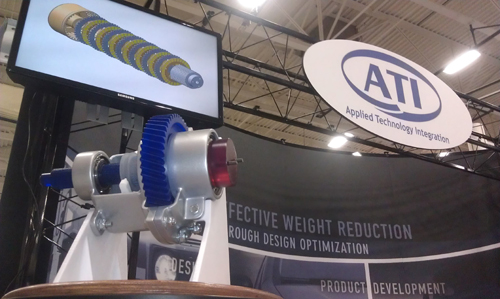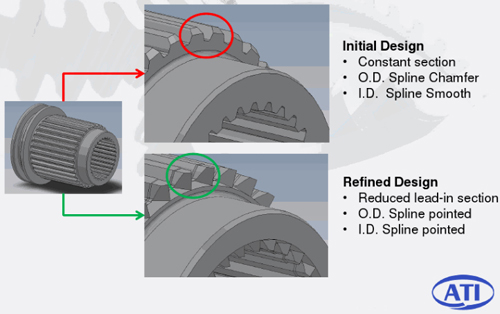Applied Technology Integration Applies Additive Manufacturing to its Design Process

Applied Technology Integration. Courtesy of ATI
Latest News
August 7, 2012
Here at Rapid Ready, I talk a lot about how additive manufacturing (AM) can improve the development cycle for new parts or products. But how does that happen, exactly? Applied Technology Integration (ATI) was kind enough to meet with me, answer questions and provide me with insight into how AM fits into its product development process.
ATI was founded in 1986 by a group of engineers that left American Motors Corporation (AMC) to begin their own business. As a result of the background of the founders, ATI is predominantly a wheeled vehicle engineering company. The company also works in other parts of the automotive industry, defense, agriculture, heavy truck and aerospace. The services offered by ATI include product development, engineering, FEA, design, prototyping and testing.
Based in Maumee, OH, not far from the shores of Lake Erie, the company is focused on providing expertise for powertrain/drivetrain, suspension and chassis development. In the last 10 years, ATI has developed ties with the defense industry for retrofit and modification design and development, along with the company’s niche powertrain and suspension expertise.
ATI has a single Stratasys Dimension Elite printer on site for prototyping, but (as is often the case) subcontracts projects that require different processes.
“One of the things we always consider is how the prototype is intended to be used by our customers,” says Scott Chapman, business development for ATI. “We’ll take that information and work with companies like Met-L-Flo and C.ideas to devise an engineered approach to the best materials for this particular situation. ATI will then engineer the solution with a design for additive manufacturing approach.”
Developing Hybrid Drive Technology
ATI was contracted to assist in the development of a new hybrid drive technology. The client that approached ATI had experience with hydraulics and electronic controls, but no in-house expertise in drivetrain design. This lack of experience was an obstacle for the client when it came time to demonstrate the hybrid drive technology to potential customers.
The specific need was for a gearbox and transfer case, and the case study itself focuses on a single function of the transfer case, specifically the shifting function. ATI uses a 10-step development process, broken down into four blocks. The goal of the development process is to eliminate guesswork, reduce cost and combat time delays.
According to ATI, it can often take up to a full year to develop a new drivetrain, transmission and transfer case. Using AM can cut that time up to half to about 170 days. Other technologies that speed up the process include simulation tools like Romax and virtual kinematics, along with CAE analysis.
Once the virtual simulations have produced a product that is within design specifications and allotted tolerances, ATI moves to rapid functional verification, i.e. AM prototyping. The company uses the prototype to focus on areas in which it has less confidence. In this particular case, the engineering team was concerned with the shifting function of the transfer case.
“There was no money in the program to use clutching, to have shift-on-the-fly capabilities, to use hydraulics, or electronics,” says Chapman. “The solution had to be strictly mechanical.”
Building an actual, functional prototype using subtractive manufacturing methods was undesirable due to cost and time constraints. The company used its 3D printer to create a functional prototype to determine how well the shifting function would hold up to repeated usage.
The AM-created prototype revealed that the alignment and fluidity of the shifting function held up, but the repeatability was less than satisfactory. Failing early to allow time for improvement is one area in which AM is far ahead of more traditional manufacturing methods for prototyping.
“Innovation is a big word around this building. We very much entertain innovative solutions to problems,” says Chapman. “If somebody has something that they think works on paper or mathematically kind of works, or is close to working, we’ll go prototype it using additive manufacturing.”
Feedback based on the prototype led to further design changes intended to improve durability. The next iteration of the design succeeded in repeatability, which gave the company the confidence to begin using traditional manufacturing methods to build parts for a functional prototype. The final demonstration for the client was a success and even included a display model built using AM.
Additive Manufacturing and Flow
Beyond the case study, ATI has found AM offers unique opportunities for design and engineering that wouldn’t otherwise be feasible. Chapman was particularly excited by the possibilities offered by clear AM materials. By combining clear 3D printed parts and parts off the shelf, ATI has been able to build functional prototypes that can be run with lubrication at vehicle top end speed to visually determine lubrication flow.
“I think any automotive engineer, or any engineer in the wheeled vehicle industry, will tell you that one of the most difficult things to do in the analytical world is to understand lubrication flow,” says Chapman. “Using production parts inside a clear housing that can support the loads — you’re able to get a good look inside as to where the lubricant is going.”
Below you’ll find a short video that shows a virtual representation of the shifter mechanism described in the case study at work.
Source: ATI
Subscribe to our FREE magazine, FREE email newsletters or both!
Latest News
About the Author
John NewmanJohn Newman is a Digital Engineering contributor who focuses on 3D printing. Contact him via [email protected] and read his posts on Rapid Ready Technology.
Follow DE







